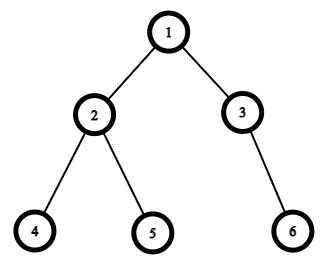CF1749F.Distance to the Path
普及/提高-
通过率:0%
AC君温馨提醒
该题目为【codeforces】题库的题目,您提交的代码将被提交至codeforces进行远程评测,并由ACGO抓取测评结果后进行展示。由于远程测评的测评机由其他平台提供,我们无法保证该服务的稳定性,若提交后无反应,请等待一段时间后再进行重试。
题目描述
You are given a tree consisting of n vertices. Initially, each vertex has a value 0 .
You need to perform m queries of two types:
- You are given a vertex index v . Print the value of the vertex v .
- You are given two vertex indices u and v and values k and d ( d≤20 ). You need to add k to the value of each vertex such that the distance from that vertex to the path from u to v is less than or equal to d .
The distance between two vertices x and y is equal to the number of edges on the path from x to y . For example, the distance from x to x itself is equal to 0 .
The distance from the vertex v to some path from x to y is equal to the minimum among distances from v to any vertex on the path from x to y .
输入格式
The first line contains a single integer n ( 2≤n≤2⋅105 ) — the number of vertices in the tree.
Next n−1 lines contain the edges of the tree — one per line. Each line contains two integers u and v ( 1≤u,v≤n ; u=v ) representing one edge of the tree. It's guaranteed that the given edges form a tree.
The next line contains a single integer m ( 1≤m≤2⋅105 ) — the number of queries.
Next m lines contain the queries — one per line. Each query has one of the following two types:
- 1 v ( 1≤v≤n ) — the query of the first type;
- 2 u v k d ( 1≤u,v≤n ; 1≤k≤1000 ; 0≤d≤20 ) — the query of the second type.
Additional constraint on the input: there is at least one query of the first type.
输出格式
For each query of the first type, print the value of the corresponding vertex.
输入输出样例
输入#1
6 1 2 1 3 4 2 5 2 3 6 14 2 4 5 10 2 1 3 1 6 2 1 1 10 20 2 6 6 10 20 1 3 2 3 2 10 0 2 5 2 10 1 1 1 1 2 1 3 1 4 1 5 1 6
输出#1
10 0 30 50 50 40 40 40 20
说明/提示
The tree from the first example:
 Some query explanations: - " 2 4 5 10 2 ": affected vertices are {4,2,5,1,3} ;
Some query explanations: - " 2 4 5 10 2 ": affected vertices are {4,2,5,1,3} ;
- " 2 1 1 10 20 " and " 2 6 6 10 20 ": all vertices are affected, since distance to 1 ( 6 ) is less that 20 for any vertex;
- " 2 3 2 10 0 ": affected vertices are {3,1,2} ;
- " 2 5 2 10 1 ": affected vertices are {5,2,4,1} .